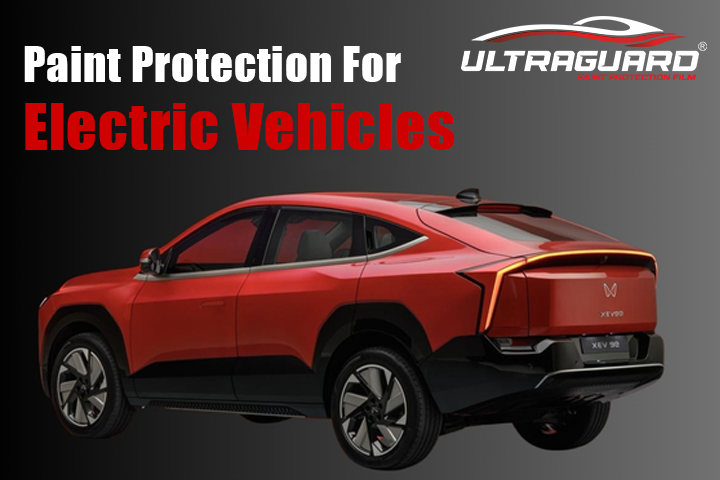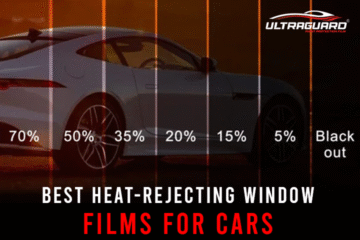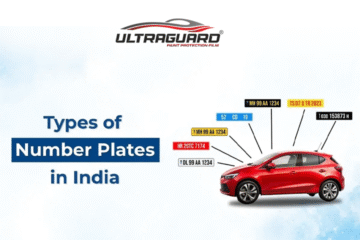The automotive world is transforming at a breakneck pace with electric vehicles (EVs), and with them comes advancements in clean and efficient mobility. One of sleek designs, technological wizardry, and environmental friendliness, EVs are more than a means of transport; they’re a testimonial.
As they increasingly become part of our landscape on the road, an important question surfaces among responsible owners: How do we keep our investment safe and in its factory-fresh state? The solution, more and more, is Paint Protection Film.
Paint protection for electric vehicles is more important than ever because of the unique aspects of these vehicles, such as their frequently elegant, space-age looks and use of cutting-edge battery systems. To achieve optimal aerodynamics, EVs frequently feature larger, more aerodynamic body panels than conventional ICE cars, which may accentuate even minor blemishes.
Preventive treatment like Paint Protection Film for electric vehicles is a worthwhile choice since the long-term value and appearance of an EV are major factors to consider in the determination of its resale value.

The Inherent Flaws of EV Paintwork
Although their incredible engineering, the paint on EVs’ outsides is exposed to all sorts of natural and road hazards, like any vehicle.
Your vehicle’s finish may be bombarded continually by stone chips, road trash, bird droppings, bug splats, and even intense UV light, resulting in ugly scratches, swirl marks, fading, and oxidation. These injuries aren’t just cosmetic to EV owners, particularly those who have paid top dollar for more expensive models; they can rob the car of its otherworldly appearance and overall worth.
Think about the typical conditions: Cruising down newly asphalted roads covered with lots of gravel, driving downtown with lots of stop-and-go traffic and crowded streets, or even just parking outside where there is always the possibility of tree sap and bird droppings.
All of these situations directly threaten your EV’s finish. A small scratch, if not treated, has the potential to cause greater damage, possibly exposing the underlying metal and increasing the chances of rust, something any EV owner would not want to deal with.
Welcome, Paint Protection Film: The Invisible Shield
Paint Protection Film, or PPF for short, is a clear, self-healing, heat-moldable urethane film carefully applied to the outside surfaces of a vehicle. This extremely tough layer is an enduring coating that absorbs the force of road debris, resists scratches, and protects the paint behind it from the elements and environmental contaminants. It’s like an invisible set of armor for your electric car.
The technology supporting PPF is simply amazing. Newer PPF features self-healing capabilities, so small scratches and swirls will just vanish when subjected to heat, either in the sun or from a heat gun. This wonder feature keeps your EV’s finish consistently perfect, without the need for excessive paint corrections and touch-ups.
Why Paint Protection Film for Electric Vehicles is a Game-Changer
The advantages of using Paint Protection Film for Electric vehicles are many and specifically respond to the particular requirements of EV owners:
Better Impact Resistance
EVs usually drive on diverse roads, and the possibility of stone chips and debris on the road is always there. PPF offers a strong physical barrier that efficiently repels such impacts, ensuring chips, dings, and deep scratches do not reach your vehicle’s original paint. This is perhaps the greatest benefit, as a single stone chip is expensive to repair and lowers the vehicle’s appearance.
Unmatched Scratch Protection
From accidental contact with shrubs to thoughtless car wash habits, scratches are unavoidable with car ownership. Top-grade electric car paint protection by means of PPF effectively reduces the occurrence of such surface blemishes. The self-healing nature of the film causes most small scratches to fade away by themselves, leaving a perpetually smooth and gleaming surface.
Environmental Contaminant Protection
Bird droppings, tree sap, bug splatters, and industrial fallout can etch your car paint if left on for an extended period of time. PPF provides a non-porous coating that allows dirt, such as these pesky contaminants, to be easily cleaned. Its chemical resistance also protects against acidic material that would otherwise etch your paint permanently.
Protection Against UV Rays
Direct exposure to damaging ultraviolet (UV) rays over a prolonged period may cause the paint to age and oxidize, primarily bright colors that are most commonly used on EVs. PPF protects against such harmful rays, which helps maintain your EV’s original color vibrancy and richness for many years. This keeps long-term visual value intact.
Maintenance of Resale Value
A spotless exterior is a huge factor in a car’s resale value. By shielding your vehicle from frequent causes of paint damage, Paint Protection Film for Electric vehicles protects your car from looking old and worn, resulting in a greater resale value when it’s time to trade or sell. It pays off in the long term.
Improved Aesthetics
Although protection is the priority, PPF also improves the appearance of your EV. It can give your car a deeper shine and a more even, smoother finish that makes it stand out. In addition to those, some PPF products come in matte finishes for those who want their ride to have a unique appearance while still benefiting from top-notch protection.
Easier Cleaning
Electric vehicles that are covered with Paint Protection Film are notoriously low-maintenance when it comes to cleaning. The hydrophobic, smooth surface of the film will push water and grime away, and cleaning is faster and more efficient. More time spent on the road driving your electric vehicle and less time spent cleaning it.
The Process of Application: Precision and Expertise
Applying Paint Protection Film to Electric vehicles is a delicate and precise process that requires expertise. It’s not for novice do-it-yourself enthusiasts. Expert technicians apply specialized tools and techniques to ensure an invisible, bubble-free, and seamless application.
The process generally calls for:
Careful Cleaning and Decontamination
The vehicle surface must be properly cleaned and decontaminated, without any dirt, grime, or imperfection, before film application.
Cutting Precision
PPF is often computer-aided design (CAD) pre-cut, specific to each make and model of car, such that there is a precise fit on every edge, curve, and panel.
Professional Installation
The film is then applied meticulously with a slip solution and squeegees such that a thin, even bond with the paint is created without the ingress of air bubbles or folds.
Healing
After applying, the film will have to cure and bond fully with the paint, and this could take a number of hours or even days, depending on the type of film and conditions.
Choosing an experienced and qualified installer is essential in maximizing results and backing up the long-term life of your electric car paint protection.
Investing in the Future of Your EV
Paint Protection Film for Electric vehicles is something that can cost anywhere from a few hundred to over a thousand dollars, depending on the size of the vehicle, how much coverage one wants (full vehicle or partial), and the quality of film and installation.
Though it is an upfront cost, the eventual return in terms of paint repair savings, detailing cost savings, and maintained resale value usually makes it a valuable investment.
Take into consideration the potential expense of painting one panel after stone chips or the removal of numerous swirl marks. These expenses have the tendency to accelerate and usually surpass the initial expenditure on electric vehicle paint protection. In addition, the assurance that your priceless EV is protected from the hardships of the road cannot be estimated.
With personal transportation being redefined by electric vehicles, making them last and look new for years to come has become imperative. Paint Protection Film provides an established and extremely effective solution for protecting your EV’s body from unsightly damage, ensuring you can drive your futuristic vehicle for years without worrying about ugly marks. It’s not about painting protection; it’s about future-proofing mobility.
If you want to know more range of PPF visit this link – https://www.ultraguardindia.com/product
Selecting the Appropriate Paint Protection Film for Electric Vehicles
Not all Paint Protection Film is the same. When picking Paint Protection Film for EV, the following factors come into consideration:
Material Quality
The superior PPF is produced using thermoplastic polyurethane (TPU), a material with superior elasticity, strength, and self-healing capacity.
Less expensive films may be constructed using PVC, which may be less robust, become yellowish over time, and be harder to remove without scratching the paint. Always ask about what material composition the film has.
Thickness
The Thickness of PPF is generally quoted in ‘mils’ (thousandths of an inch). Thicker films provide more protection against impacts.
Though 8-10 mil is the general thickness, certain brands provide thicker varieties for better protection, particularly for vehicles regularly exposed to rough conditions.
Clarity and Finish
Optically clear, first-rate electric vehicle paint protection film should not distort or haze your EV’s original paint color and finish. Some films have a high-gloss finish that adds an extra layer of depth to the paint, while matte films are available for those who want a satin appearance.
Self-Healing Properties
This is the signature of contemporary PPF. Make sure your chosen film has strong self-healing properties, so small scratches and swirl marks vanish with heat.
It’s such a handy feature and ensures that the film retains its showroom-new appearance in the long term.
Hydrophobic Properties
Most high-end PPF products nowadays come equipped with hydrophobic topcoats that push away water and impurities. This simplifies washing your EV and prevents water spots, a concern that car owners frequently have, especially in hard water regions.
Warranty
Good PPF brands and installers provide warranties against yellowing, cracking, bubbling, and peeling. A good warranty is reassuring and reflects the manufacturer’s faith in their product. Generally, warranties last between 5 to 10 years, sometimes even more.
Brand Reputation
Use well-established and reliable brands in the Paint Protection Film market. Ultraguard, etc., are market leaders with reputations for research and development and rigorous quality control. Reading reviews and testimonials can also assist in making your choice.
If you want to know more visit contact us
Keeping Your PPF-Covered EV Maintained
The benefits of electric vehicle paint protection are further enhanced by the incredibly simple maintenance that follows the application of Paint Protection Film:
Frequent Washing
Clean your car on a frequent basis using a mild microfiber wash mitt and a pH-neutral auto soap. Don’t use harsh chemicals or rough brushes since these may damage the film.
Steer Clear of Automated Car Washes (Caution)
Although most contemporary PPFs are scratch-resistant, certain automated car washes, particularly those equipped with heavy-duty brushes, can still employ abrasive chemicals or too much friction, which will inevitably compromise the film. Hand washing or washing with a touchless automatic cleaner is safer.
Spot Cleaning
Get rid of bug splatters, tree sap, and bird droppings as soon as you can. Even with PPF, these kinds of pollutants are more difficult to remove the longer they are present on the paint.
Steer Clear of Wax with Petroleum Distillates
Sealing or waxing your PPF is acceptable, but steer clear of anything that has petroleum distillates since they will break down the film over time. Employ PP, F-specific waxes or sealants, or simply add a ceramic coat on top of the film to maintain protection and gloss.
Professional Inspection
Have your PPF professionally inspected once a year. Installers will look for any small problems and suggest optimal care tips, guaranteeing the durability of your PPF coating on your vehicle.
The Long-Term Value Proposition
The investment in Paint Protection Film for Electric vehicles is not about the paint protection alone; it’s about the protection of your overall investment. EVs are at the forefront of automotive tech, and their owners will usually enjoy keeping their vehicles in top condition.
An EV that is properly protected will not only appear more attractive but also retain its value better when it is sold.
In the constantly changing EV market, where new designs and technologies are released regularly, keeping your existing vehicle’s structural integrity and aesthetic appeal is a factor in its future depreciation.
A car with perfect original paint, covered by a top-grade PPF coating for car, will always be more attractive to potential buyers and fetch a higher price than a car with visible scratches, chips, and fading.
In addition, for lessees of electric vehicles, electric vehicle paint protection can be a priceless commodity. Lease contracts usually have provisions on excessive wear and tear. By dissuading paint damage, most prone to occur, PPF can prevent costly penalties on lease termination, demonstrating its fiscal sense.
Read also :-
Paint Protection Film: Your Essential Buying Guide
How Paint Protection Film Helps the Environment: Eco-Friendly Advantages Explained
Must-Have Accessories for Your New Car: Top 10 Picks
Why Many Car Detailing Studios Hit the Skids: A Deep Dive into Industry Pitfalls
Can Paint Protection Film Save Your Money?
Ultraguard Window Tint to Keep Your Car Cool in the Summer Heat
Is Your Car Ready for the Rain? Ultimate Monsoon Car Maintenance Checklist
Decoding Car Window Tinting Laws in India
Ultimate Summer Car Care Tips Every Driver Should Know
Conclusion
As the world transitions to electric vehicles, the demand for effective paint protection solutions will continue to rise. Paint Protection Film is the most comprehensive and effective way of protecting the body of these new-age machines.
Its impact-absorbing quality, scratch resistance, contaminant repellency, and even self-healing capabilities make it an irreplaceable guard for your EV’s paint job.
Spending money on Paint Protection Film for Electric vehicles is not a luxury; it’s a smart choice that protects your investment, preserves the visual splendor of your vehicle, and adds to your mobility experience.
By opting for a good film and an expert installer, you’re not only protecting your car; you’re ensuring that the future of your mobility looks as clean and exciting as the moment you drove it home for the very first time. With PPF, your EV isn’t only road-ready; it’s ready for whatever the future holds.
Frequently Asked Question(FAQs) on PPF for Electric Vehicles
Below are some of the most common questions asked about Paint Protection Film for Electric vehicles, addressing key concerns and offering insightful information to EV owners:
1. Isn’t EV paint the same as normal car paint, & Is PPF needed on an electric vehicle?
Even though EV paint is identical to paint on regular cars, it is typically created using water-based, more ecologically friendly paints that are softer and more likely to peel and scratch. Additionally, EVs are more vulnerable to road debris due to their unique aerodynamic profiles, which include larger, smoother panels and lower ground clearance in some areas.
With the generally higher initial purchase price of an EV and the need to preserve its showroom, otherworldly appearance, and resale value, electric vehicle paint protection using PPF is strongly advised to protect against typical damage such as stone chips, scratches, and environmental debris.
2. How long does Paint Protection Film last on an EV?
The life of Paint Protection Film also depends on the quality of the film, the skill of the installation, and how well it’s cared for. Top-of-the-line TPU-based PPFs from well-known manufacturers normally have warranties between 5 to 10 years, and sometimes even longer with good care. Its life can be shortened by excessive UV exposure, chemicals, and misuse of washing techniques.
3. Does car PPF yellow over the years, particularly on white electric vehicles?
Earlier versions of PPF, especially PVC ones, used to turn yellow with time because of exposure to UV rays and oxidation. Modern Paint Protection Film (based on Thermoplastic Polyurethane or TPU) is specifically designed with improved UV inhibitors as well as anti-yellowing agents.
Although no material is entirely immune to the effects of long-term, intense exposure to UV radiation, top-quality TPU films are quite resistant to yellowing and are made to retain clarity for the life of their warranty. If you see a yellow color, it’s generally caused by surface debris (such as dirt or pollution) and not the film itself, which can generally be wiped off.
4. Will Paint Protection Film impact my EV’s range or efficiency because of increased weight?
No, Paint Protection Film weighs virtually nothing. It is an incredibly thin film, and its little weight will not make any kind of measurable difference to your electric vehicle’s range, efficiency, or performance.
5. Can I install Paint Protection Film myself for cost savings?
Although DIY kits are available, Paint Protection Film application on Electric vehicles is a very complex and demanding process involving specialized tools, a dust-free area, and extensive expertise. It can result in bubbles, creases, lifted edges, and a damaged finish, which would cost a lot to correct.
For the best outcome and for the paint protection of the electric vehicle to last and work as expected, professional installation by a qualified and experienced installer is highly advised.
6. Where on my EV should I apply PPF?
The most frequently protected areas with Paint Protection Film are the “high-impact” areas most vulnerable to damage:
- Full Front: This would cover the entire hood, front bumper, fenders, side mirrors, and headlights.
- Partial Front: Protects the front bumper, approximately 18-24 inches of the hood and fenders, and side mirrors.
- Full Vehicle: Offers full-body protection for all painted surfaces of the vehicle.
Other areas also widely treated are door edges, rocker panels, rear bumper loading zones, and even interior trim pieces.
7. Can a ceramic coating be applied over Paint Protection Film?
Yes, definitely! Indeed, the use of a ceramic coating on top of Paint Protection Film is a favored option for ultimate electric vehicle paint protection. The PPF itself offers physical protection in the form of chips and scratches, and then the ceramic coating puts an additional layer of hydrophobic characteristics to the surface, making it even simpler to clean, with improved gloss, as well as additional UV protection. It’s a synergistic strategy that merges the best of both worlds.
8. How do I take care of and clean my EV after PPF is applied?
- Taking care of a PPF-covered EV is usually easier compared to an unprotected vehicle.
- Washing: Wash with a pH-neutral automobile soap and soft microfiber wash mitts. Use the “two-bucket method.” Never use abrasive brushes or strong chemicals.
- Drying: Dry with a clean, soft microfiber towel or a car blower/dryer to avoid water spots.
- Avoid Automatic Car Washes: Particularly the kind with rotating brushes, for the possibility of scuffing the film or picking up edges. Touchless car washes are better, but hand washing is always best.
- Spot Cleaning: Clean bird droppings, tree sap, and bug guts immediately, as they can etch into the film if they sit for a while.
- Skip Petroleum-Based Products: Refrain from applying waxes or sealants with petroleum distillates on your PPF because they weaken the film.
- Periodic Inspection: Inspect your film periodically for any signs of damage or lifting.
9. Is PPF removable without harming the original paint?
Yes, premium Paint Protection Film is made to be removed safely by a professional installer without distorting the original factory paint underneath, assuming the paint was original and fully cured when applied. The adhesive of the film is made to stick firmly but also release cleanly, with no marks or residue.
10. Is electric vehicle paint protection using PPF worth the expense?
Considering the cost of repainting panels due to chips and scratches, the time saved on detailing, and the significant impact on your EV’s resale value, the initial investment in high-quality Paint Protection Film often pays for itself. It offers unparalleled protection, maintaining your EV’s “showroom” look for years, and providing peace of mind against common road hazards and environmental damage. For those owning an EV and intending to retain it for quite some time or who desire to retain its resale value, PPF is very much a worthwhile expense.




0 Comments